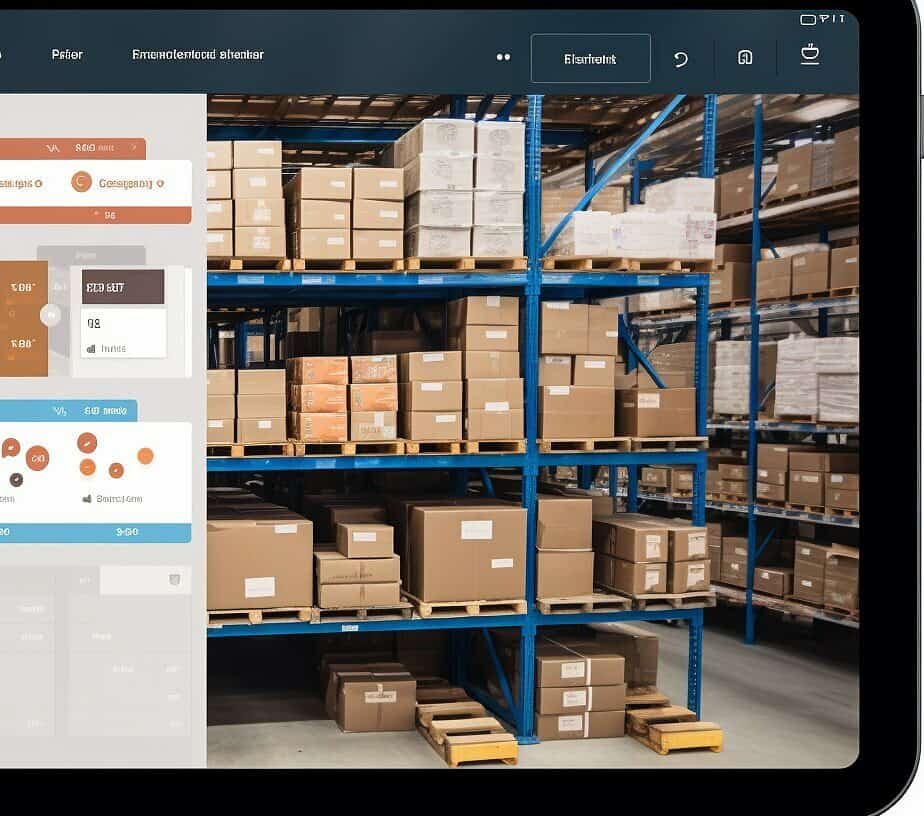Welcome to our guide to No Code Inventory Management Systems. As a business owner, you know that inventory management is a crucial aspect of your operations. It can be time-consuming, tedious, and prone to error if done manually. That’s where No Code Inventory Management Systems come in, offering a streamlined and automated solution. In this article, we’ll explain what No Code Inventory Management Systems are, their key features, benefits, and how they can help you improve inventory control. We’ll also guide you through the process of choosing and implementing the right system for your business.
What are No Code Inventory Management Systems?
If you’re not familiar with No Code Inventory Management Systems, otherwise known as no-code inventory management software or low-code inventory solutions, don’t worry – you’re not alone. These systems are a relatively new type of inventory management tool that are becoming increasingly popular among businesses of all sizes.
Unlike traditional inventory management software, which requires programming skills to use and customize, no-code inventory management systems are designed to be used by anyone, regardless of their technical abilities. This is because they use a visual, drag-and-drop interface that allows users to create custom workflows and processes without writing any code.
What are the advantages of using a no-code approach?
There are several advantages to using a no-code approach to inventory management:
- Speed: No-code systems allow you to create and customize inventory management workflows quickly and easily, without waiting for IT support or hiring a developer.
- Flexibility: No-code systems are highly customizable, so you can easily tailor them to your specific business needs.
- Automation: No-code systems can be integrated with other business tools, such as e-commerce platforms and accounting software, to automatically update inventory levels and reduce the need for manual data entry.
Overall, No Code Inventory Management Systems offer a simpler, more intuitive way to manage your inventory, allowing you to focus on growing your business rather than getting bogged down in administrative tasks.
Key Features of No Code Inventory Management Systems
No Code Inventory Management Systems offer an array of features that streamline and automate inventory management, reducing manual labor. Here are some of the key features that enable businesses to better manage their inventory:
| Feature | Description |
|---|---|
| Automated Inventory Tracking | No Code Inventory Management Systems use barcode scanning or RFID technology to track inventory in real-time, reducing manual labor and the risk of errors. This allows businesses to maintain accurate inventory counts and assess stock levels with ease. |
| Inventory Control Software | No Code Inventory Management Systems offer inventory control software that allows businesses to set reorder points, track stock levels, and optimize inventory levels. This enables businesses to avoid overstocking or understocking, reduce carrying costs, and ensure they always have enough inventory to meet customer demand. |
| Integrations with Other Systems | No Code Inventory Management Systems can integrate with other systems, such as POS systems and accounting software, to provide a comprehensive view of a business’s operations. This allows businesses to make more informed decisions and optimize their inventory management. |
| Cloud-based System | No Code Inventory Management Systems are often cloud-based, which means they can be accessed from anywhere with an internet connection. This makes it easy for businesses to manage their inventory across multiple locations, and allows remote staff to access the system as needed. |
By using No Code Inventory Management Systems, businesses can take advantage of these features to simplify and optimize their inventory management processes.
Benefits of No Code Inventory Management Systems
No Code Inventory Management Systems offer a range of benefits for businesses of all sizes, from small startups to large enterprises. By simplifying inventory management and reducing manual labor, these systems can help businesses to save time, improve accuracy, and increase productivity. Below are some of the key advantages of No Code Inventory Management Systems:
- Improved accuracy: By automating inventory tracking and reducing manual data entry, No Code Inventory Management Systems can help to improve accuracy and reduce costly errors that can impact a business’s bottom line.
- Time savings: No Code Inventory Management Systems can help businesses to reduce the time and effort required for inventory management tasks, freeing up staff to focus on more strategic activities and improve overall productivity.
- Scalability: As businesses grow and evolve, their inventory management needs can change significantly. No Code Inventory Management Systems are designed to be flexible and scalable, allowing businesses to adjust and expand their inventory management capabilities as needed.
- Inventory management for small businesses: No Code Inventory Management Systems can be particularly useful for small businesses, which may have limited resources and staff to devote to inventory management. These systems can help small businesses to streamline their operations, reduce waste, and improve profitability.
- Cloud-based inventory systems: Many No Code Inventory Management Systems are cloud-based, meaning that they can be accessed from anywhere with an internet connection. This can be particularly useful for businesses with multiple locations or remote employees, as well as those that need to access inventory data on the go.
Overall, No Code Inventory Management Systems offer a range of benefits that can help businesses to improve their operations and achieve their goals more effectively. By automating inventory tracking, reducing manual labor, and providing real-time data and insights, these systems can help businesses to optimize their inventory levels, reduce waste, and improve profitability.
How No Code Inventory Management Systems Improve Inventory Control
No Code Inventory Management Systems provide a range of features that help businesses optimize their inventory control. Here are some ways these systems can improve inventory control:
Automated Inventory Tracking
One of the biggest advantages of No Code Inventory Management Systems is the ability to automate inventory tracking. By integrating with barcode scanners or RFID systems, these systems can track inventory in real-time as it moves from one location to another, making it easy to keep track of inventory levels and quickly identify discrepancies. This reduces the need for manual labor and can significantly improve accuracy, helping businesses to avoid stockouts or overstocking.
Inventory Optimization Tools
No Code Inventory Management Systems can also help businesses optimize their inventory levels. By analyzing factors such as historical sales data, lead times, and seasonality, these systems can recommend optimal reorder points and quantities. Businesses can also use these tools to create rules for stock replenishment, such as automatically generating purchase orders when inventory falls below a certain threshold. This reduces the risk of stockouts and overstocking, helping businesses to balance their inventory levels and improve profitability.
Overall, No Code Inventory Management Systems provide businesses with powerful tools to streamline their operations, improve accuracy, and optimize inventory levels. By automating inventory tracking and offering a range of inventory optimization tools, these systems can help businesses stay ahead of the competition and achieve their goals.
Choosing the Right No Code Inventory Management System for Your Business
Choosing the right No Code Inventory Management System can be a daunting task, but it’s an important decision for any business looking to streamline their inventory tracking and management processes. Here are some tips for evaluating different systems and selecting the best fit for your business:
- Determine your inventory tracking needs: Before looking at specific systems, consider what features and functionality you require to effectively track your inventory. Do you need real-time tracking? Automated stock replenishment? Customizable dashboards? Make a list of your priorities and use them as a guide when evaluating different systems.
- Consider your budget: No Code Inventory Management Systems come in a range of price points, from free to thousands of dollars per month. Determine how much you’re willing to spend and look for systems that fit within your budget.
- Research different systems: Once you know what you’re looking for and how much you’re willing to spend, research different No Code Inventory Management Systems. Look for reviews, testimonials, and case studies to get a sense of how the system performs in real-world scenarios.
- Request demos: Before committing to a system, request a demo or free trial. This will give you an opportunity to test the system and make sure it meets your needs.
- Consider scalability: As your business grows, your inventory tracking needs may change. Look for a system that can easily scale with your business, whether that means adding new users, expanding into new locations, or tracking additional product lines.
- Factor in implementation costs: Keep in mind that implementing a new No Code Inventory Management System may require an upfront investment of time and resources to migrate data, customize the system to your needs, and train your staff. Factor in these costs when evaluating different systems.
Implementing a No Code Inventory Management System
Implementing a No Code Inventory Management System can seem daunting at first, but with the right approach, it can be a straightforward process. Here are some practical steps to guide you through:
1. Take stock of your current inventory management process
Before implementing a new system, it’s important to understand how your current inventory management process works. This will help you identify which tasks and processes can be streamlined or automated with a No Code Inventory Management System. It’s also a good time to clean up your inventory data and ensure it’s accurate and up-to-date.
2. Choose the right No Code Inventory Management System for your business
As discussed earlier, choosing the right No Code Inventory Management System is essential for success. Consider your specific business needs, such as inventory volume, industry, and budget, when evaluating different options. Additionally, prioritize user-friendliness and scalability.
3. Customize the system to fit your business needs
Once you have chosen a No Code Inventory Management System, take the time to customize it to your specific business needs. This may involve setting up data fields, configuring automations, and creating access permissions for different users.
4. Migrate your inventory data to the new system
Migrating inventory data from your old system to the new No Code Inventory Management System can be a complex process, but there are tools and services available to help simplify it. Ensure your data is clean, organized, and complete before initiating the migration.
5. Train your staff on the new system
It’s important to provide adequate training and support to your staff when implementing a new inventory management system. Ensure they understand how to use the system and its features, and encourage them to provide feedback and suggestions for improvement.
6. Monitor and optimize the system over time
Finally, it’s important to continuously monitor and optimize your No Code Inventory Management System to ensure it remains effective for your business needs. Use data and analytics to identify areas for improvement, and be open to updating and tweaking the system as needed.
No Code Inventory Management Systems vs. Traditional Inventory Management Software
When considering inventory management, businesses have two main options: No Code Inventory Management Systems and traditional inventory management software. While both options aim to streamline inventory tracking and control, they differ in several key ways.
No Code Inventory Management Systems use a modular, drag-and-drop interface to create custom inventory management solutions. These systems require little to no coding knowledge and can be quickly customized to fit a business’s specific needs. In contrast, traditional inventory management software typically requires more coding knowledge and customization, resulting in a longer implementation time.
Another key difference is the level of automation. No Code Inventory Management Systems utilize automation for tasks such as inventory tracking and stock replenishment, whereas traditional systems may require more manual input. This automation leads to increased accuracy and time savings, especially for smaller businesses with limited resources.
Pros and Cons of Both Approaches
While No Code Inventory Management Systems offer several advantages, traditional inventory management software has its own strengths as well. For example, traditional systems may offer more robust reporting capabilities or integrate better with pre-existing systems. However, these systems often require more time and resources to implement and maintain.
| No Code Inventory Management Systems | Traditional Inventory Management Software |
|---|---|
| Customizable with minimal coding knowledge | May require more coding knowledge for customization |
| Quick and easy to implement | Longer implementation and setup time |
| Automated inventory tracking and control | May require more manual input and oversight |
| Scalable and flexible to business needs | May be less flexible or require more customization |
Ultimately, the choice between No Code Inventory Management Systems and traditional inventory management software depends on a business’s specific needs and resources. Small businesses may benefit more from the quick implementation and automation of No Code Inventory Management Systems, while larger organizations may require the robust reporting and integration capabilities of traditional systems.
Case Studies: No Code Inventory Management Systems in Action
Many businesses have successfully implemented No Code Inventory Management Systems, resulting in improved accuracy, efficiency, and scalability. Here are a few examples:
| Business | Industry | Inventory Challenges | Results |
|---|---|---|---|
| ABC Bakery | Food and Beverage | Poor inventory control and tracking, frequent stockouts, manual data entry | Implemented a cloud-based No Code Inventory Management System with automated inventory tracking, real-time reporting, and customizable alerts. Reduced stockouts by 80%, decreased manual data entry by 60%, and improved overall inventory accuracy by 90%. |
| XYZ Hardware | Retail | Difficulty managing inventory across multiple locations, lack of real-time visibility into stock levels | Implemented a No Code Inventory Management System with centralized inventory control and real-time reporting. Improved inventory accuracy by 85%, reduced stockouts by 70%, and gained better visibility into stock levels across all locations. |
| LMN Manufacturing | Manufacturing | Difficulty managing a growing number of SKUs, manual inventory tracking and ordering | Implemented a No Code Inventory Management System with automated inventory optimization tools and streamlined ordering processes. Reduced manual labor by 50%, improved accuracy by 95%, and increased scalability to accommodate a growing number of SKUs. |
These businesses demonstrate the versatility of No Code Inventory Management Systems and their potential for improving inventory management in a variety of industries and contexts.
FAQ: Common Questions about No Code Inventory Management Systems
As with any new technology, you may have questions about implementing a No Code Inventory Management System in your business. Here are some common questions and answers to help you make an informed decision.
What is a No Code Inventory Management System?
A No Code Inventory Management System is a type of inventory management software that allows users to create custom inventory tracking and management tools without the need for coding or programming knowledge. This software allows businesses to streamline administrative tasks and automate inventory tracking, reducing manual labor.
What are the benefits of using a No Code Inventory Management System?
Using a No Code Inventory Management System can result in improved accuracy, time savings, and scalability. These systems are particularly useful for small businesses and those that rely heavily on inventory management, as they offer cloud-based solutions that can be accessed from anywhere.
How do I choose the right No Code Inventory Management System for my business?
When choosing a No Code Inventory Management System, consider factors such as the size and complexity of your inventory, your budget, and any previous inventory management tools you have used. Look for software that offers features such as automated inventory tracking, real-time data, and customizable dashboards.
How do I implement a No Code Inventory Management System in my business?
Implementing a No Code Inventory Management System in your business will require some initial planning and customization. You will need to migrate your existing data into the new system, customize the software to meet your business needs, train staff on how to use the system, and ensure user adoption. It’s important to have a plan in place to ensure a smooth transition.
How does a No Code Inventory Management System differ from traditional inventory management software?
Traditional inventory management software typically requires some level of coding or programming knowledge to set up and customize. No Code Inventory Management Systems, on the other hand, allow users to create custom tools without the need for coding knowledge, streamlining the process and reducing manual labor.
Is a No Code Inventory Management System right for my business?
If your business relies heavily on inventory management, or if you are looking to streamline administrative tasks and reduce manual labor, a No Code Inventory Management System may be right for you. Consider the benefits and features offered by these systems, and weigh them against your business needs and budget before making a decision.




0 Comments